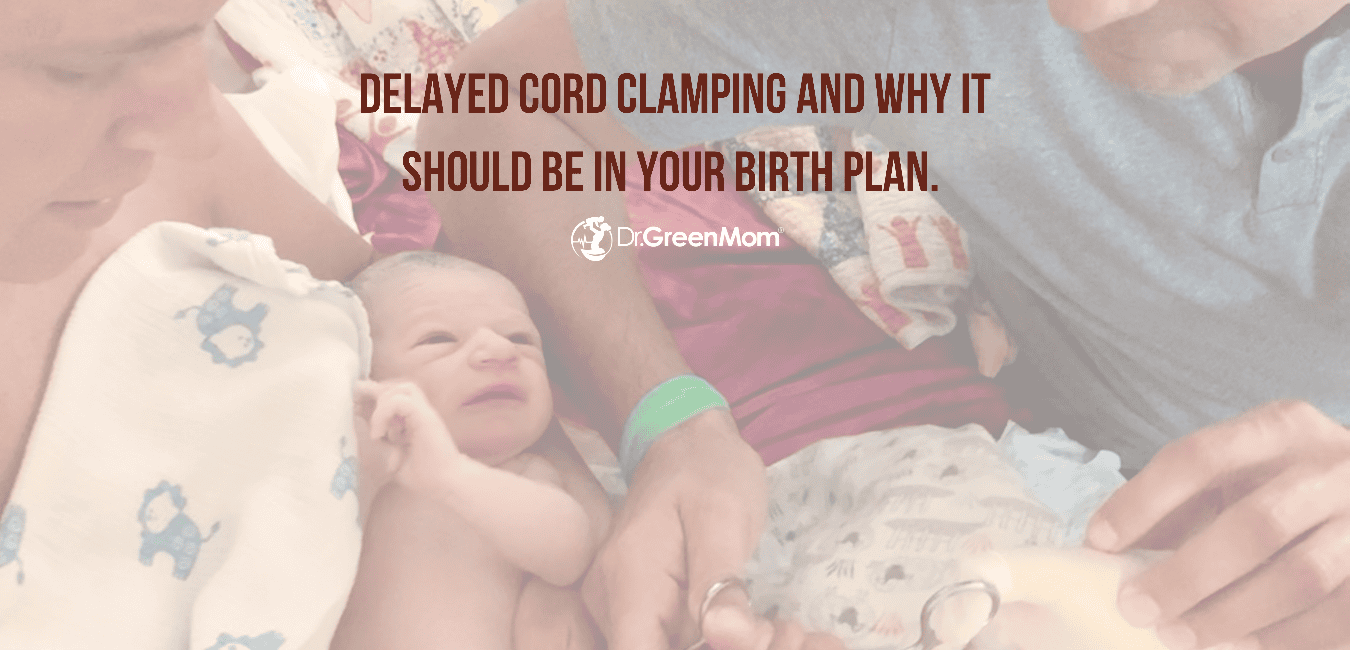Delayed cord clamping is a birthing practice that is recommended by the American Academy of Pediatrics (1) and the World Health Organization (2). The benefits of delayed cord clamping span from improved hematologic status (3) to enhanced neurodevelopmental outcomes (4).
In this article, we’ll discuss delayed umbilical cord clamping, including the benefits and potential risks for both full term and preterm infants, as well as go over how delayed cord clamping works in various birth scenarios, including vaginal deliveries, cesarean sections, and multiples.
What Is Delayed Cord Clamping?
Essentially, it is the practice of delaying the clamping of the umbilical cord after birth to allow for more blood to flow from the placenta to the baby. The umbilical cord is the connection between the baby and the placenta. The placenta is a temporary organ developed during pregnancy that delivers oxygen and nutrients to a growing baby through the umbilical cord.
Immediately after birth, a baby is still attached to the placenta and receives nutrients for several minutes. Previously, the standard was to clamp the umbilical cord immediately after birth, but in more recent years many practices have begun to delay clamping of the cord for several minutes in order to allow the cord blood to transfer to the baby.
How Long Can Cord Clamping Be Delayed?
When it comes to delayed cord clamping, most recommendations suggest a delay of one to five minutes, while some doctors advise observing the cord and placenta and clamping when the cord turns pale in color and stops pulsing, which usually happens within the 5 minute window post birth but can sometimes take longer.
Some people choose to practice a lotus birth where the cord is allowed to remain attached to the placenta until it naturally dries and detaches, which can take up to 10 days. The practice of lotus birthing comes with several risks and is not what we are referring to in this article when we discuss delayed cord clamping.
What Are The Benefits Of Delayed Cord Clamping?
1. Reduces The Risk Of Anemia
The practice of delayed cord clamping allows additional blood to flow from the placenta to the baby, significantly lowering the risk of iron deficiency anemia in infancy (3). The extra blood, estimated to be about 80-100 ml, is rich in iron and stem cells crucial for the baby’s development and immune system. In fact, research shows that 100 ml of cord blood contributes an additional 40-50 mg of iron per kg of body weight (5). Research has shown that delayed cord clamping can reduce the need for blood transfusions in full-term infants (5).
 2. Stabilizes Infant Blood Pressure
2. Stabilizes Infant Blood Pressure
For full-term infants delayed cord clamping offers the benefit of stabilizing blood pressure in the immediate after birth period (5).
3. Reduces Certain Risks Associated With Premature Birth
For premature infants in particular, delayed cord clamping offers the benefit of reduced risks of necrotizing enterocolitis and intraventricular hemorrhage (6).
4. Improves Social & Motor Skills
The benefits of delayed cord clamping can extend well into childhood: A Swedish study has found that at four years old children who underwent delayed cord clamping at birth had improved social and motor skills when compared to their peers (4).
What Are The Disadvantages Of Delayed Cord Clamping?
While the benefits are many, delayed cord clamping may carry a small risk of a condition in newborns called jaundice (7). Waiting to clamp the cord allows more blood to flow from the placenta to the baby, and this extra blood contains more red blood cells. After birth, the baby’s body breaks down extra red blood cells, which produces a substance called bilirubin. If the baby’s liver can’t process the bilirubin quickly enough, it builds up in the body.
Jaundice may necessitate treatment with UV lamps in some cases and often resolves on its own. It is important to note that more recent research suggests that the association between delayed clamping and jaundice might not be as significant as previously thought (8).
For preterm babies at higher risk for breathing complications, immediate medical attention may take precedence over delayed cord clamping, although alternatives like umbilical cord milking — the process of gently squeezing the cord to push blood towards the baby before clamping it — present a compromise, offering similar benefits without as much delay. Though it’s not as widely studied as delayed cord clamping, there’s no evidence to suggest cord milking causes harm, and it may provide similar benefits — in a shorter amount of time — as delayed cord clamping.
In the case of maternal hemorrhage, infant distress, or other complications that necessitate urgent action, delayed cord clamping presents too much of a risk and is foregone in favor of urgent intervention.
Delayed Cord Clamping In Various Birth Scenarios
Many expecting mothers have heard of the benefits of delayed cord clamping, but wonder about its feasibility for their unique situation. If delayed cord clamping is something you would like to have included in your birth plan make sure to discuss this with your prenatal care team to see how it fits into your unique birth. Here is a general overview of how delayed cord clamping might look in a few different scenarios:
Vaginal Birth
In uncomplicated vaginal deliveries, delayed cord clamping can usually be integrated into the birth process with the newborn (cord still attached) placed on the mother’s belly, allowing for the natural transfer of blood from the placenta. If for any reason the baby needs immediate medical care, cord milking may be practiced, or the cord may be cut immediately in order to better care for the baby’s urgent needs.
C-Section
It is possible to implement delayed cord clamping in the case of cesarean sections (C-sections), though this isn’t always practiced so it is an important discussion to have with your team if delayed cord clamping is something you desire for your cesarean birth.
In a routine c-section, a gentle approach to birth for the infant that includes delayed cord clamping may involve delivering the baby’s head first, which allows the newborn to begin breathing and crying with the umbilical cord still connected, facilitating continued blood flow from the placenta during the slower birth. Then, post-delivery, placing the baby on the mother’s abdomen or legs allows for skin-to-skin contact while the umbilical cord is still pulsating, supporting the infant’s transition outside the womb and merging the health benefits of delayed cord clamping with the bonding and thermal benefits of immediate skin-to-skin contact.
Delayed cord clamping is not always done during c-section births and that oftentimes has to do with concerns around managing the maternal condition and blood loss. This is something to discuss with your doctor. An alternative would be cord milking, which can serve as an adjunct to delayed cord clamping in C-section births. This technique is particularly valuable in cesarean deliveries where the natural contractions of the uterus, which facilitate blood transfer to the baby, are absent or reduced.
Multiples
When it comes to delayed cord clamping with multiples, especially multiples sharing a placenta (monochorionic twins), there is reason for extra consideration due to the risk of acute intertwin transfusion (9). However, for non-monochorionic multiples, delayed cord clamping remains advisable in the absence of other complications.
Delayed Cord Clamping & Cord Blood Banking
Since the amount of blood usually transferred to the infant when delayed cord clamping is practiced can be up to 180 ml, and only about 50 ml is usually needed for cord blood banking, it is possible to practice delayed cord clamping and cord blood banking. Combining these two practices requires a bit of a balancing act between maximizing the health benefits for the newborn and collecting viable stem cells for future use. Meaningful donations are still possible with clamping delays of 30 to 60 seconds (10).
Summary
Delayed cord clamping is the practice of leaving the umbilical cord attached to the baby and the placenta for several minutes after birth in order to allow more blood and cord cells to make their way into the baby before severing the connection. Delayed cord clamping can be performed after vaginal, cesarean section, and multiple births with some exceptions. By understanding the benefits and potential risks of delayed cord clamping, parents can make informed decisions that support the best possible start for their newborns.
References:
- Delayed Umbilical Cord Clamping After Birth. (n.d.). Www.acog.org. https://www.acog.org/clinical/clinical-guidance/committee-opinion/articles/2020/12/delayed-umbilical-cord-clamping-after-birth
- Optimal timing of cord clamping for the prevention of iron deficiency anaemia in infants. (n.d.). Www.who.int. https://www.who.int/tools/elena/interventions/cord-clamping
- Ranjit, T., Nesargi, S., Rao, P. N., Sahoo, J. P., Ashok, C., Chandrakala, B. S., & Bhat, S. (2015). Effect of early versus delayed cord clamping on hematological status of preterm infants at 6 wk of age. Indian journal of pediatrics, 82(1), 29–34. https://doi.org/10.1007/s12098-013-1329-8
- Andersson, O., Lindquist, B., Lindgren, M., Stjernqvist, K., Domellöf, M., & Hellström-Westas, L. (2015). Effect of Delayed Cord Clamping on Neurodevelopment at 4 Years of Age: A Randomized Clinical Trial. JAMA pediatrics, 169(7), 631–638. https://doi.org/10.1001/jamapediatrics.2015.0358
- Raju, T. N., & Singhal, N. (2012). Optimal timing for clamping the umbilical cord after birth. Clinics in perinatology, 39(4), 889–900. https://doi.org/10.1016/j.clp.2012.09.006
- Lodha, A., Shah, P. S., Soraisham, A. S., Rabi, Y., Abou Mehrem, A., & Singhal, N. (2019). Association of Deferred vs Immediate Cord Clamping With Severe Neurological Injury and Survival in Extremely Low-Gestational-Age Neonates. JAMA Network Open, 2(3), e191286. https://doi.org/10.1001/jamanetworkopen.2019.1286
- Shao, H., Gao, S., Lu, Q., Zhao, X., Hua, Y., & Wang, X. (2021). Effects of delayed cord clamping on neonatal jaundice, phototherapy and early hematological status in term cesarean section. Italian Journal of Pediatrics, 47(1). https://doi.org/10.1186/s13052-021-01069-6
- Sonbol, B., Orabi, A., & Al Najjar, H. (2024). Impact of the Timing of Umbilical Cord Clamping on Maternal and Neonatal Outcomes in Saudi Arabia. Cureus, 16(2), e53536. https://doi.org/10.7759/cureus.53536
- Ghirardello, S., Di Tommaso, M., Fiocchi, S., Locatelli, A., Perrone, B., Pratesi, S., & Saracco, P. (2018). Italian Recommendations for Placental Transfusion Strategies. Frontiers in pediatrics, 6, 372. https://doi.org/10.3389/fped.2018.00372
- BeTheMatch.org. (2024, February 23). Cord blood FAQs. Bethematch.org. https://bethematch.org/support-the-cause/donate-cord-blood/cord-blood-faqs/



2 Comments